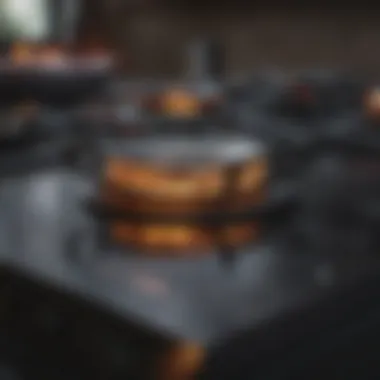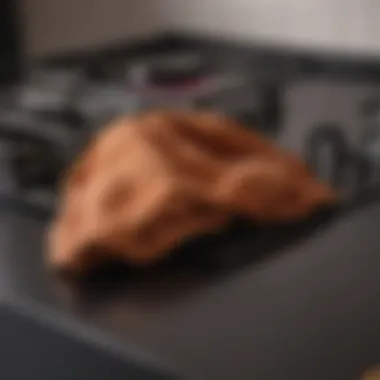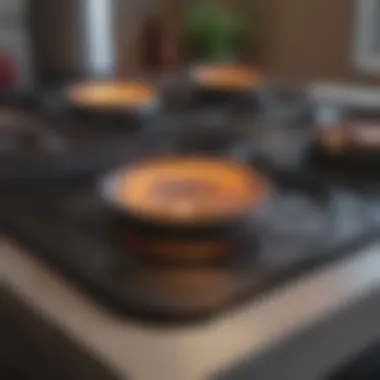Top Techniques for Stain Removal on Black Stove Tops


Intro
Maintaining the pristine look of black stove tops can be a challenge. They are elegant and have a nice aesthetic appeal, yet they can stain easily. This article explores effective techniques to aid in removing stains and offering preventive measures that help keep your stove top looking new.
When stains occur, they can detract from the overall appearance of your kitchen. Understanding the types of stains typically found on black stove tops is key. Grease, food splatters, and hard water stains can leave unsightly marks. Knowing how to address each type systematically ensures your cleaning endeavors yield desired results.
Using various cleaning agents effectively is essential. Some agents may be more appropriate for a specific type of stain than others. This comprehensive guide reviews its methods thoughtfully and step-by-step to ensure clarity.
Maintaining a clean kitchen goes beyond aesthetics; it impacts overall health and safety. A dirty stove top can harbor bacteria or cause unwanted flavors in your cooking. Thus, having a solid understanding of effective cleaning techniques is not just practical, it's necessary.
Understanding the Stains
Understanding what you are up against is crucial.
- Grease Stains: Often occurring from spills, they can cling resolutely to surfaces. Quick action works best for these.
- Food Splatter: Mixed with heat, stuck pieces can harden, making them difficult to remove once set.
- Hard Water Marks: These frequently appear after boiling water or cooking, leaving a cloudy residue.
Identifying these allows one to prepare the most effective cleaning strategy. Each stain has its specific cleaning technique, affecting how quickly and easily you resolve the issue.
Cleaning Agents Overview
Multiple cleaning products can help remove stains from black stove tops. Here are some common and effective choices:
- Vinegar: A natural non-toxic cleaner known for its ability to tackle grease and mineral deposits.
- Baking Soda: Mild abrasive quality makes it an ideal choice for scrubbing without scratching.
- Stove Top Cleaner Products: Products like Cerama Bryte and Bar Keepers Friend can provide professional results if used correctly.
Blending combinations of these items can improve outcomes. For instance, mixing baking soda with water creates a paste perfect for stubborn stains.
Step-by-Step Cleaning Process
Once you've chosen your cleaning agent, follow these steps:
- Preparation: Always ensure the stove top is cool to avoid burns.
- Positioning: For utensils and gadgets close to the stove, repositioning them clears the area properly.
- Application: Apply your chosen cleaner liberally on stained areas.
- Scrubbing: Use a soft cloth or sponge to scrub the surface in circular movements. For stubborn spots, a gentle abrasive cloth may be necessary.
- Rinsing: After scrubbing, wipe with a damp cloth to remove residue.
- Drying: Use a dry microfiber cloth for a polished finish.
Concluding each session should leave that stove top looking remarkable once more.
Preventive Measures
Preventing stains contributes significantly to better maintenance of these surfaces:
- Be prompt in cleaning food spills as soon as they occur.
- Regularly degrease areas around stove burners to keep buildup minimal.
- Use a splatter guard to reduce splashes during cooking.
These methods not only keep surfaces cleaner but extend the lifespan of your stove top, ensuring it maintains its desired look for years to come.
Sythesizing Insights
Having explored different stains, cleaner options, and processes, one should feel empowered in maintaining black stove tops. By understanding each approach and adapting based on circumstances, favorable outcomes can become consistent. Educated cleaning moves the necessary transition to sustaining a safe and visually appetizing kitchen view.
Understanding the Challenge of Black Stove Tops
Cleaning black stove tops can be a true test of one's patience. The sleek black surface, while aesthetically pleasing, is known for showing stains more easily than other surfaces. This necessity emphasizes the challenge it presents not only for those working in kitchens but also for anyone keen on maintaining a pristine environment.
Why Stains Are More Visible on Black Surfaces


A black stove top can enhance the beauty of a kitchen. However, it also serves as a canvas for any imperfection. Stains, spots, and smudges are immediately noticeable against a black backdrop. This sharp contrast signifies that your cleaning efforts must be more frequent and more thorough. Regular maintenance becomes crucial to uphold the sleek appearance. This is not just about beauty; notably, any stain may compromise hygiene as well.
Common Types of Stains Found on Black Stove Tops
- Food Residue: Food residue is one of the most common stains encountered. When food spills or cooking splatter come into contact with a hot surface, they can dry quickly and form a tough, hardened layer. Foods that contain sugar or have a tendency to burn are especially problematic, as they generate sticky residues that are harder to remove. Failure to clean the food residue promptly can lead to permanent discoloration and extensive scrubbing during subsequent cleanings.
- Burnt Marks: Burnt marks can appear unattractive. These occur when food not only cooks on the burner but also burns and sticks onto the surface. They are particularly daunting for removal and, if left unaddressed, may become permanent. Though they typically signal a home cook's unfamiliarity with heat management, it is essential to understand the best practices for removing these marks to preserve the stove's visual appeal.
- Oils and Grease: Oils and grease buildup can significantly cloud the overall shine of black stove tops. These substances are often remnants of cooking processes and accumulate over time. Grease is distinctive as it can attract additional dirt and debris, aggravating its presence. Addressing grease stains promptly is necessary to prevent them from becoming an even bigger challenge in the cleaning process.
“Regular cleaning of black stove tops is essential to prevent the buildup of stains, ensuring longevity and aesthetic appeal.”
In summary, understanding the challenges and types of stains found on black stove tops prepares homeowners for better cleaning practices. It sets the stage for a more structured approach towards cleaning, boosting confidence and efficacy in maintaining these surfaces.
Preparing for Cleaning
Cleaning a black stove top requires preparation. This ensures better results and reduces frustration. Understanding your supplies and safety measures can streamline the process, making it less daunting. Being well-prepared also helps in understanding the specific cleaning strategies suited for black surfaces, which often show marks and stains more prominently.
Gathering the Necessary Supplies
Gathering the right supplies is essential for effective cleaning. Using suitable items contributes significantly to achieving a satisfactory outcome.
Microfiber Cloths
Microfiber cloths are a key component in the cleaning process. Their unique structure allows them to pick up dirt efficiently without scratching surfaces. These type of cloths trap more particles compared to regular fabric. Therefore, they are beneficial when cleaning black stove tops, as they leave less lint and residue.
An additional advantage is that microfiber cloths are easy to wash. However, they can lose their effectiveness over time if not maintained properly. It is advisable to rinse and dry them after each use to retain their cleaning capabilities.
Cleaning Solutions
Choosing the right cleaning solution is fundamental. Various solutions are available that can gently cleanse greasy stains or food remnants without harming the surface. Popular options include mild dish soap and vinegar, known for their natural disinfectant qualities. Such cleaning solutions do not contain harsh chemicals, which is a significant benefit when maintaining a glossy black finish.
Many effective cleaning solutions have additional features such as being eco-friendly. Users may prefer them, taking into consideration both health and environmental aspects.
Scrubbing Tools
Scrubbing tools should also be chosen wisely. Using inappropriate tools can damage the stove top. Non-abrasive scrubbers like soft sponges are usually recommended. These tools allow you to clean tough marks efficiently without risking scratches.
A good scrubbing tool should have enough durability but not the rough texture of scouring pads.Those can compromise the sleek surface of the stove. Opting for softer alternatives, even if they require a bit more elbow grease, could prove beneficial in fostering the stove's longevity.
Safety Precautions to Consider
Taking safety precautions when cleaning is crucial. It protects not just the stove but also the user. Being mindful of these measures ensures a safer cleaning experience.
Cooling Down the Stove
Before initiating cleaning, it is vital to allow the stove to cool down. This reduces the risk of burns. Furthermore, heat can set some stains, making removal tougher later. Allowing sufficient time for your stove to cool improves the overall cleaning approach. It can also enhance the effectiveness of certain cleaning solutions. This element serves as a straightforward but wise precaution every user should consider.
Choosing Non-Abrasive Tools
Choosing non-abrasive tools is important for the surface integrity of the stove top. Abrasive materials can create scratches and mar the glossy finish. Non-abrasive options keep the stove looking new longer. Their effectiveness often equates to the careful application of pressure on surfaces rather than forceful scrubbing. Hence, identifying and utilizing suitable tools should be part of the overall planning.
Taking these precautions and gathering the right supplies sets the stage for efficient cleaning. When all is ready, one can proceed confidently to tackle the daunting task of stain removal on black stove tops.
Step-by-Step Cleaning Techniques
Cleaning black stove tops requires specific know-how and techniques due to their unique surface characteristics. The importance of following a structured approach lies in both effectiveness and safety. With various cleaning methods available, each offers distinct benefits depending on the nature of the stains. Moreover, avoiding harsh chemicals and abrasive tools is paramount to preserve the stove top's finish.


Using Mild Soap Solution
Starting with a mild soap solution is often the best approach for regular cleaning. This method is effective at removing light stains and day-to-day spills without harming the surface. To create a soap solution, mix a few drops of liquid dish soap with warm water.
- Prepare Your Materials: Gather a microfiber cloth and a bowl for the soapy mixture. Microfiber is critical for this process as it is non-abrasive and will not scratch the stove surface.
- Dampen the Cloth: Dip the microfiber cloth into the soapy water and wring it out. It should be damp but not soaked.
- Multidirectional Wipes: Gently wipe the surface in a circular motion. Rinse the cloth regularly to avoid spreading dirt.
- ** rinse the Area**: After wiping, use a separate damp cloth with plain water to remove any soap residue. Finally, dry the surface with a clean, dry microfiber cloth for a streak-free finish.
Adopting this method regularly can maintain cleanliness without much hassle.
Applying Vinegar and Baking Soda
This combination serves not only as a cleaning technique but also as a natural deodorizer. It effectively targets stubborn stains caused by burnt food or grease. Here are the steps:
- Prepare the Mixture: On a dry stove top, sprinkle baking soda over the stained areas. Then, using a spray bottle, cover the baking soda with white vinegar.
- Let it Sit: Allow the combination to sit for about 10 to 15 minutes. The fizzing reaction helps break down tough stains.
- Gentle Scrubbing: After resting, use a microfiber cloth to wipe away the mixture. The gentle action helps dislodge grime without scratching.
- Final Rinse: As before, run a clean damp cloth over the surface to eliminate any residue from the cleaning agents used. Dry with a clean towel to avoid streaks.
This technique not only cleans but also helps control potential odors from cooking.
Utilizing Commercial Cleaners
In cases where natural methods are insufficient, commercial cleaners can offer a quick solution. Products like Bar Keepers Friend or Magic Eraser are formulated to fight more stubborn stains without damaging black surfaces. When selecting these, always check the label for compatibility.
- Test Before Application: Prior to widespread use, test a small hidden part of the stove to prevent adverse reactions.
- Application Process: Apply a tiny amount directly onto the stained area. Follow the product’s instructions, often requiring a brief waiting period.
- Wipe with Care: Using a soft cloth, gently wipe away the cleaner as suggested. Usually, a damp cloth suffices but some might require general minimal scrubbing.
- Thorough Rinse: A careful rinse with water is essential to wash off any chemical residue. Dried thoroughly, it keeps the stove looking immaculate.
This approach ensures that even the most entrenched stains can be addressed while preserving the surface integrity.
Each cleaning method offers unique benefits. Understanding the right approach will significantly enhance the maintenance of black stove tops.
Handling Stubborn Stains
Stains on black stove tops can become a significant irritation for homeowners. They can affect the appearance of the kitchen, which many take pride in. Handling stubborn stains is essential for keeping these surfaces looking presentable. This section outlines two fundamental approaches to address persistent stains: scraping techniques and utilizing heat. Understanding how to effectively remove these blemishes not only enhances the visual appeal of the stove but can also prolong its life.
Scraping Techniques for Tough Residue
When dealing with stubborn residue, scraping can often prove to be an effective method. This involves using a scraper designed specifically for glass or ceramic surfaces.
- Choose Appropriate Scraper: Select a scraper with a straight, sharpened edge, ensuring it is non-metallic to avoid scratching the stove. Common tools might include a plastic or ceramic scraper.
- Angle of Approach: Hold the scraper at a shallow angle to the surface. This helps to lift away the residue without digging into the surface material.
- Pressure Control: Apply gentle, consistent pressure while scraping. Too much force can lead to scratches, while too little may not remove the stain effectively.
"Always test the scraping technique on a small, inconspicuous area to prevent damage."
Once you carefully scrape off the residue, use a cleaning solution to wipe the surface clean. Regular cleaning post-scraping can help maintain your stove’s pristine appearance.
The Role of Heat in Stain Removal
Utilizing heat is another effective method for removing tough stains. Heat loosens food residues and stubborn stains, making them easier to clean. Here are the steps:
- Turn on the Stove: Gradually heat the stove by turning it on to a low temperature. Let it warm up for a few minutes but avoid overheating as this may set the stains.
- Apply a Cleaning Solution: Once warm, apply a gentle cleaner or a vinegar and water solution. The heat will help the cleaner seep into the stains.
- Scrub Gently: After a brief waiting period, use a soft scrub pad to clean the surface. The combination of heat and cleaning solutions will help lift residues that seemed immovable.
Using heat effectively requires monitoring temperature and time to avoid potential heating issues or stains becoming more set. Proper execution of this technique can result in achieving a cleaner black stove top with minimal effort.
Preventive Measures for Maintaining Cleanliness
Maintaining cleanliness on black stove tops can be more challenging than on lighter surfaces. The sleek finish, while visually appealing, shows dirt and stains more prominently. Therefore, establishing preventive measures is crucial. A good strategy minimizes the frequency and intensity of cleaning required. An effective approach involves two primary aspects: adhering to a routine cleaning schedule and investing in protective measures.


Regular Cleaning Routine
Implementing a regular cleaning routine can greatly simplify the upkeep of your black stove top. Consistency is key. Here are some essential points to consider:
- Daily Wipe-Down: After any cooking, take a few moments to wipe down the stove using a microfiber cloth. This simple task can prevent residue from hardening and making stains more difficult to remove later.
- Spot Treatments: Address stains as soon as you notice them. Reserving a few minutes every few days to target any visible marks can help maintain the overall appearance. For instance, a gentle soap solution can effectively lift light stains before they set.
- Weekly Deep Clean: Dedicate some time each week to perform a deeper clean. During this, utilize the techniques discussed previously in briefer sections in this article, such as baking soda and vinegar or commercial cleaners.
Taking these actions not only improves the aesthetic of the kitchen but also prolongs the lifespan of the stove top.
Using Protective Covers
In addition, using protective covers can further enhance the cleanliness of your black stove top. These covers add an extra layer of defense against scratches and stains. Selecting the right type of cover is essential, consider these options:
- Stove Top Covers: These can fit securely over your stove when not in use. They are typically made from materials that are easy to clean.
- Silicone Mats: These mats can absorb and shield the surface, especially during active cooking sessions.
- Heat-Resistant Cloths: Keeping such cloths nearby can help while you cook to manage any spills. It prevents any ingredients from touching the stove surface directly.
By taking these preventive measures, you can maintain the pristine look of your black stove top. A proactive approach often outperforms reactive cleaning. With this effort, your kitchen can remain a stylish and inviting cooking space that minimally requires restoration efforts.
Product Recommendations
The relevance of product recommendations in this article cannot be overstated. Choosing the right cleaning agents and tools is critical for maintaining black stove tops. A good product not only simplifies the cleaning process but also protects the surface from damage.
Some essential considerations include
- Surface Compatibility: Ensure that the products are safe for glass and ceramic surfaces to avoid scratches.
- Stain-Specific Solutions: Products targeting particular stains such as burnt marks or grease can enhance effectiveness.
- Ease of Use: Products that are easy to apply and rinse off save you time and effort.
Top Cleaning Solutions
Many cleaning solutions are available on the market, each with its unique attributes. Some highly effective choices include:
- Bar Keepers Friend: This powdered cleanser features oxalic acid, ideal for tackling tough stains without harsh abrasives.
- Weiman Cooktop Cleaner: Formulated specifically for glass and ceramic stove tops, this liquid cleaner dissipates residues effectively.
- Cerama Bryte Cooktop Cleaner: Known for its superb grease-fighting capability, it is gentle enough not to damage the surface but tough on stains.
Before using any of these products, ensure to check user reviews and specific usage instructions to utilize them effectively.
Recommended Tools for Optimal Results
Alongside effective cleaning solutions, having the right tools is essential for optimal cleaning outcomes. Recommended tools include:
- Microfiber cloths: They trap dust and residues without scratching the surface.
- Non-abrasive sponges: Choose ones designed for sensitive surfaces to avoid damaging the cooktop.
- Scraper or razor blade: Useful for scraping off burnt-on residues, but technique is vital to protect the surface.
Using the proper tools, in conjunction with the right products, can significantly improve your stove top maintenance routine. These recommendations equip you to deal with the inevitable stains while prolonging the longevity of your appliance.
Finale
Caring for black stove tops requires patience and a strategic approach. This section highlights the importance of maintaining these surfaces, focusing on effective techniques discussed earlier. Regular cleaning ensures that your stove top remains not only visually appealing but also functional.
Benefits of Maintenance well-maintained black stove tops extend their lifespan, preventing damage from corrosive stains and scratches. Potentially detrimental substances, such as oils and food residue, can be mitigated by routine cleaning. Understanding the properties of different cleaners plays a critical role here; avoiding harsh chemicals prevents unintended consequences.
Consider adopting a proactive mindset. Always treat stains immediately, using appropriate methods, and employing recommended tools. Good practices contribute to long-term upkeep, allowing you to enjoy a pristine cooking environment.
In summary, knowing effective techniques for dealing with stains aids in sustaining the functionality and aesthetics of your stove top. Make cleaning part of your routine, and always choose tools wisely. Understanding how various removers work will boost your confidence to clean effectively.
Final Thoughts on Caring for Black Stove Tops
Reflect on the considerable responsibilities that come with owning or maintaining black stove tops. The sleek design attracts attention but requires proper handling.
A few essential takeaways for your ongoing cleaning regimen:
- Establish a regular cleaning schedule to address minor stains.
- Avoid abrasive scrubbers that may harm the surface.
- Use protective tools and covers when not in use.
By retaining these strategies in your practice, you'll uphold both the beauty and resilience of your black stove top. It serves as a valuable asset in your kitchen, functioning and looking at its best. The little efforts compound into significant outcomes over time.



